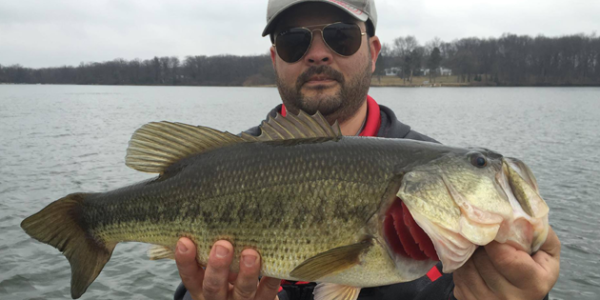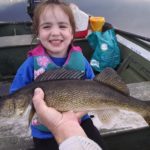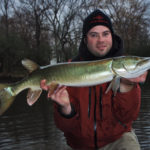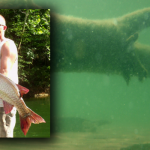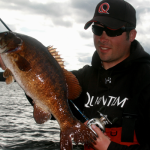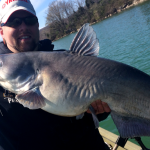By Joseph Alfe
As the water warms into the low 50 degree range across the upper Midwest, largemouth bass will shift into a more aggressive pre spawn stance. Gangs of bass will begin massing and patrolling just outside likely spawning areas, such as the mouths of smaller bays and along the shallow first breaks. Weather is a factor here too, and the frequent mid spring cold snaps will push fish off the first break into deeper water.
Do not be put off by these weather downturns, because they can concentrate fish. Case in point: After a week of near 70-degree temperatures, we endured a sudden and profound cold snap that sent daytime temps back into the 30’s and 40’s. This served to concentrate fish into the deepest water, which was about 9 feet, near the mouth of a spawning bay in a small local body of water. Once located, they were readily caught using a few techniques I will describe shortly. This produced a day to remember, as nearly 3-dozen bass, some in the 5 lb. range came to the boat.
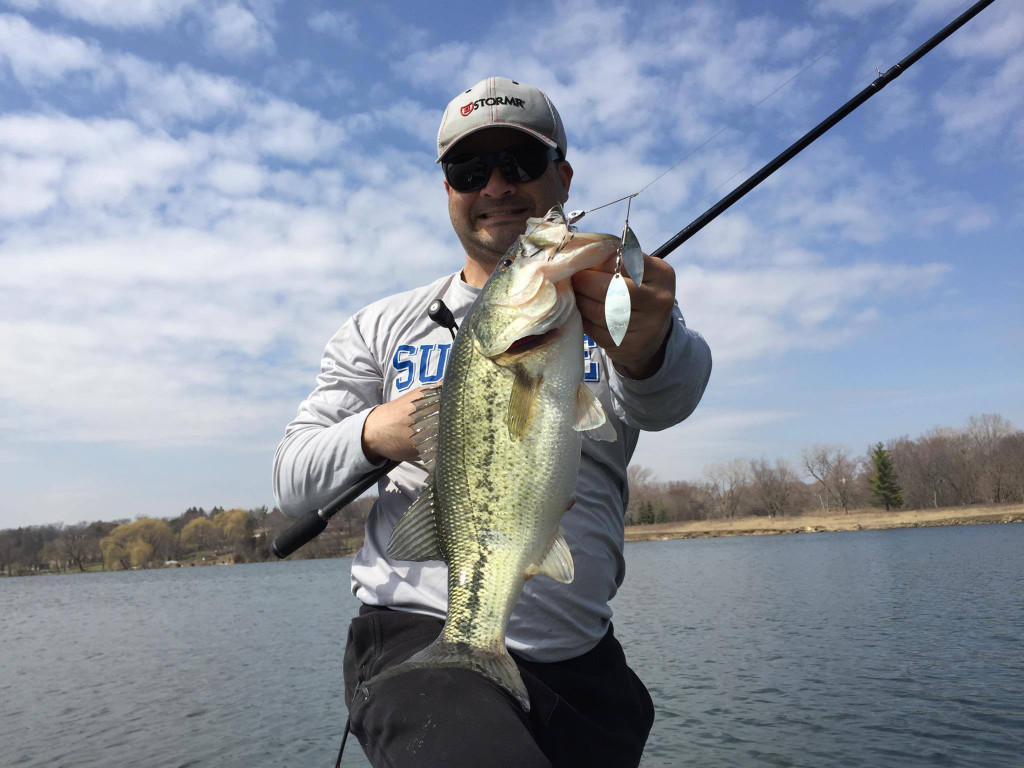
Rattlebaits
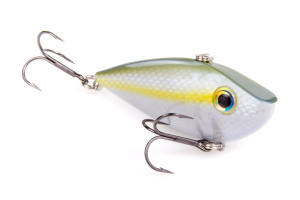 There is no secret that rattlebaits produce once the water warms into the upper 40’s. There is no wrong way to fish these baits, but many anglers limit themselves to two techniques: Burning and the Yo-Yo and no doubt these will produce, but when they don’t, it’s time to modify.
There is no secret that rattlebaits produce once the water warms into the upper 40’s. There is no wrong way to fish these baits, but many anglers limit themselves to two techniques: Burning and the Yo-Yo and no doubt these will produce, but when they don’t, it’s time to modify.
During the cold snap, bass were lethargic, and this is when conventional wisdom would direct us to throw a suspending jerkbait, and we did with some success, but we caught more and bigger fish using a modified Yo-Yo style retrieve with large rattlebaits. What we have found is that it is sometimes effective to lay your rattlebait down. What I mean is this: Cast out the bait and tight line it down to the bottom. Bass will sometimes hit the bait on the fall, so pay attention. Watch your line, and once the bait settles on the bottom, keep your rod high and line tight just as you would while working a jig. Start by making your upward snaps, experimenting how fast and far you rip upwards. Let the fish tell you.
On this day, we found a 2-3 ft. rip best. At the top of the rip, tight line the bait back down and let it settle momentarily on the bottom. This is where the majority of the strikes will occur, as bass pin the bait against the bottom. Watching your line is critical here. Bass also struck at the beginning of the next rip, and there was oftentimes a bass already on when the rip started upward. A longer rod with a heavier action and fast tip is preferable here, as the rattlebaits we were using were larger than what is normally thrown. In fact, this works best with baits of at least ½ ounce, all the way up to muskie sized 1 oz. baits. The set up I used was an Airrus 7’3” X-Entity MHF, which is as powerful as most brands heavy action rods yet extremely sensitive, an uncommon combination. For the bigger baits, I uses the Airrus X-Entity 7’3” XHXF, a rod I normally use for swimbaits. A high speed reel assists on line retrieval as baits are ripped, and I spooled my Daiwa T3 8.1:1 speed reel with 16# Sunline Supernatural Nylon line for strength and low stretch.
Speaking of swimbaits…
The second technique I will discuss is the use of large, glider type hard swimbaits. Much ado has been made of the outsize catches made with these articulated baits in the west and south, but few use them in the Midwest. This is a mistake and one that is costing you big fish. First, we will discuss the different types of hard swimbaits. There are three major categories of hard swimbaits: Gliders, multi-jointed, and lipped.
Gliders
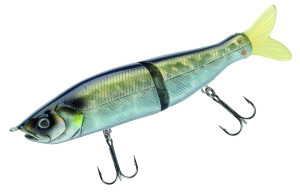 This is my favorite category, especially in colder water, and the one I will concentrate on in this article. These are single jointed baits that, when straight retrieved slowly, swim in an exaggerated S-motion. When paused or twitched, these baits glide off to the side, and will switch ends if tapped correctly. This is a deadly maneuver to entice following fish. I find that a slow, steady retrieve interspersed with pauses and taps works best. The things bass do to these baits are unreal, and they will select for the biggest bass. Do not be afraid to throw large baits, even into the 8” range, and a 5 lb. bass will have no trouble inhaling one of these.
This is my favorite category, especially in colder water, and the one I will concentrate on in this article. These are single jointed baits that, when straight retrieved slowly, swim in an exaggerated S-motion. When paused or twitched, these baits glide off to the side, and will switch ends if tapped correctly. This is a deadly maneuver to entice following fish. I find that a slow, steady retrieve interspersed with pauses and taps works best. The things bass do to these baits are unreal, and they will select for the biggest bass. Do not be afraid to throw large baits, even into the 8” range, and a 5 lb. bass will have no trouble inhaling one of these.
My favorite is the River 2 Sea S-Waver, which is a well balanced, finely detailed bait that casts well and is nearly fool proof to work. These baits can get expensive, with Gan-Craft and Roman made, two premium Japanese glide baits fetching hundreds of dollars. The River 2 Sea is reasonably priced as tested at $15.99 for the 120 4 ¾” to $45.99 for the 200 8” model at Tacklewarehouse.com. A word to the wise is to invest in tieable leader material such as Knot 2 Kinky to protect against the toothy critters who love these baits too, which is subject of another article. I use a very light 15# stranded wire direct ties to my mainline and a crosslock snap. I do not like leaders with swivels as the added weight kills action.
For main line I like 20#+ high quality fluorocarbon such as Sunline Structure FC, or a slick braid of at least 50#, such as Sunline FX2. A long, stout rod is in order, but one with a fast, light tip to work the bait. Broomsticks aren’t good here. I use the Airrus 7’3” X-Entity XHXF.
Articulated
These baist have more than two joints, sometimes with as many as four. They are straight swimmers with a tight, wiggling action, and are designed to settle on the bottom in an upright position when stopped, a deadly tactic for mondo size bass in western reservoirs feeding on stocked Trout. Spro’s Bill Seimantel’s BBZ-1 or the Triton Bull Shad are good examples of an articulated bait.
Lipped
These are basically articulated baits with and added lip that helps exaggerate swimming action, or for use as a wake bait, a deadly option once the water warms.
So there you have it, two additional techniques to add to your arsenal. Many of you will, without any doubt, add my rattlebait option, but will still fear big swimbaits. Don’t. You will be leaving big bass on the table if you do. Just tie one on and make the decision to fish it, even if you go days without action, because when it happens, you will be glad that you did.


